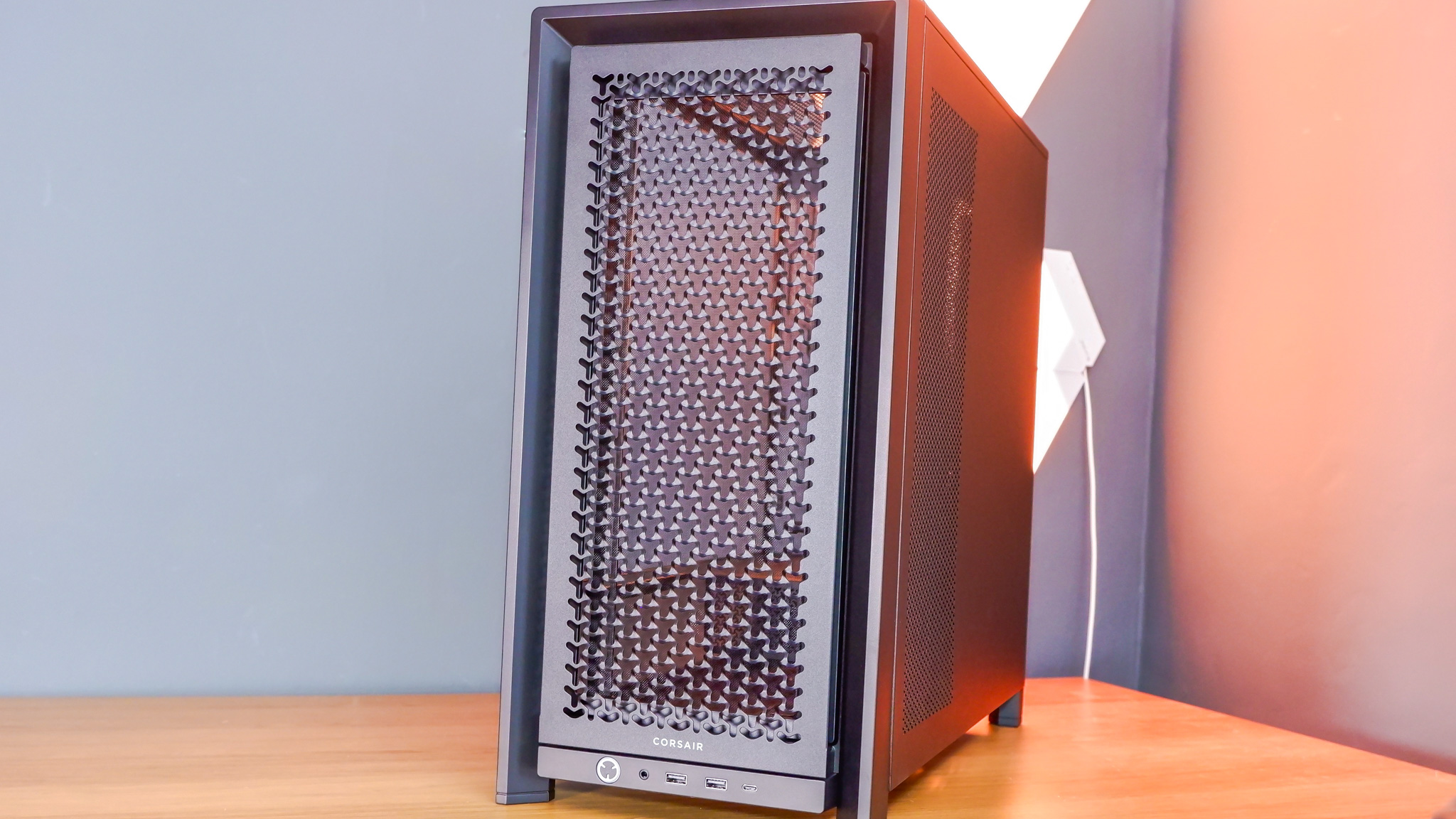Our Verdict
The Corsair Frame 4000D is a feature-filled chassis with a decent price tag. It's absolutely built for those with an iCUE obsession and it looks superb with fans a-blaze in RGB hues. However, there is room for improvement and I'd like to see Corsair roll out lots of customisation options to really make this case sing.
For
- Looks great
- Handy rail mounting system
- Includes side fan/radiator mount
- Competitive price
Against
- Panel flex
- Limited cable clearance
- Only includes 3 fans, if any
PC Gamer's got your back
My first move with the Corsair Frame 4000D was to pull it apart, panel by panel, until I was left with nothing more than a basic frame. All of a sudden the name makes sense—you can remove and replace pieces of the Frame 4000D to match your mood and, with most removed, it offers unfettered access to its insides. Insides filled with clever features, many designed for Corsair's own ecosystem.
A fairly standard size and shape, this mid-tower case is a little stubbier than the Phanteks G400A I have sat alongside it. It measures 48.6 x 49 x 23.9 cm (19.1 x 19.2 x 9.4-inches) and I've double checked those measurements and they do include the furthest reaches of the thumbscrews on the rear of the case.
It comes in black or white, and with or without fans, and there's a small price increase depending on which fans you opt for, if any.
Here's what you should expect to pay:

Size: Mid-tower
Motherboard support: E-ATX (305mm x 277mm), ATX, Micro-ATX, Mini-ITX
Dimensions: 48.6 x 49 x 23.9 cm (19.1 x 19.2 x 9.4-inches)
Weight: 10.03 kg
Maximum GPU length: 430 mm
Radiator support: Up to 360 mm (top, front + side)
Fan support: Up to 2x 200 mm (front), 2x 140 mm/3x 120 mm (top, side)
Fans included: No (reviewed), but options available
Storage bays: 2 3.5-inch/4 2.5-inch
Front panel: 1x USB 3.2 Gen 2 Type-C, 2x USB 3.2 Gen 1 Type-A, 1x 3.5 mm
Price: $95/£80 (without fans)
That's not a bad deal for some case fans. If you were to buy them separately a set of three RS120 would cost you $40 and the RS120 ARGB $55. Though the Frame 4000D does still leave me wanting for a rear exhaust fan and there's the aforementioned Phanteks G400A, which comes with four 140 mm RGB fans for $130. That's also a pretty good deal. Anyways, my sample was the black version sans fans, but Corsair provided some LX120 and LX120-R, so I've stuck those in.
You do get a pretty gorgeous chassis with the Frame 4000D. Constructed from thin sheet metal, Corsair has managed to give the 4000D an air of quality about it. There's a pull tab to remove the top panel and a hint of yellow on the captive thumbscrews across the rear for a teeny amount of flair. There's also a consistent patterning to the front, side, rear, and top panels. Heck, even the IO panels match. As does the rear of the RM850x PSU I've installed in this machine—a nice touch if you stick within the Corsair ecosystem, which as you'll soon read, I think Corsair would very much like you to do.
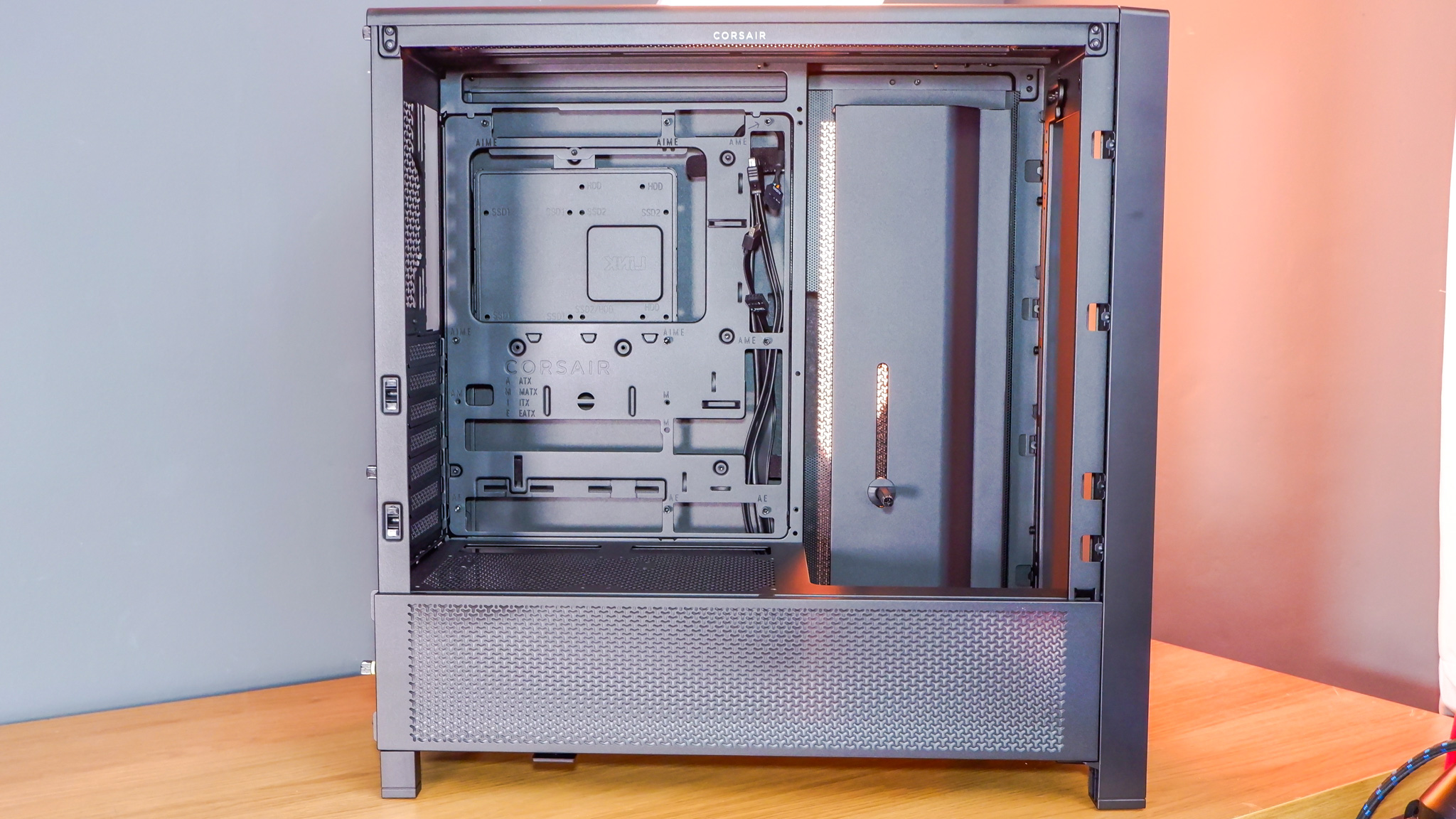
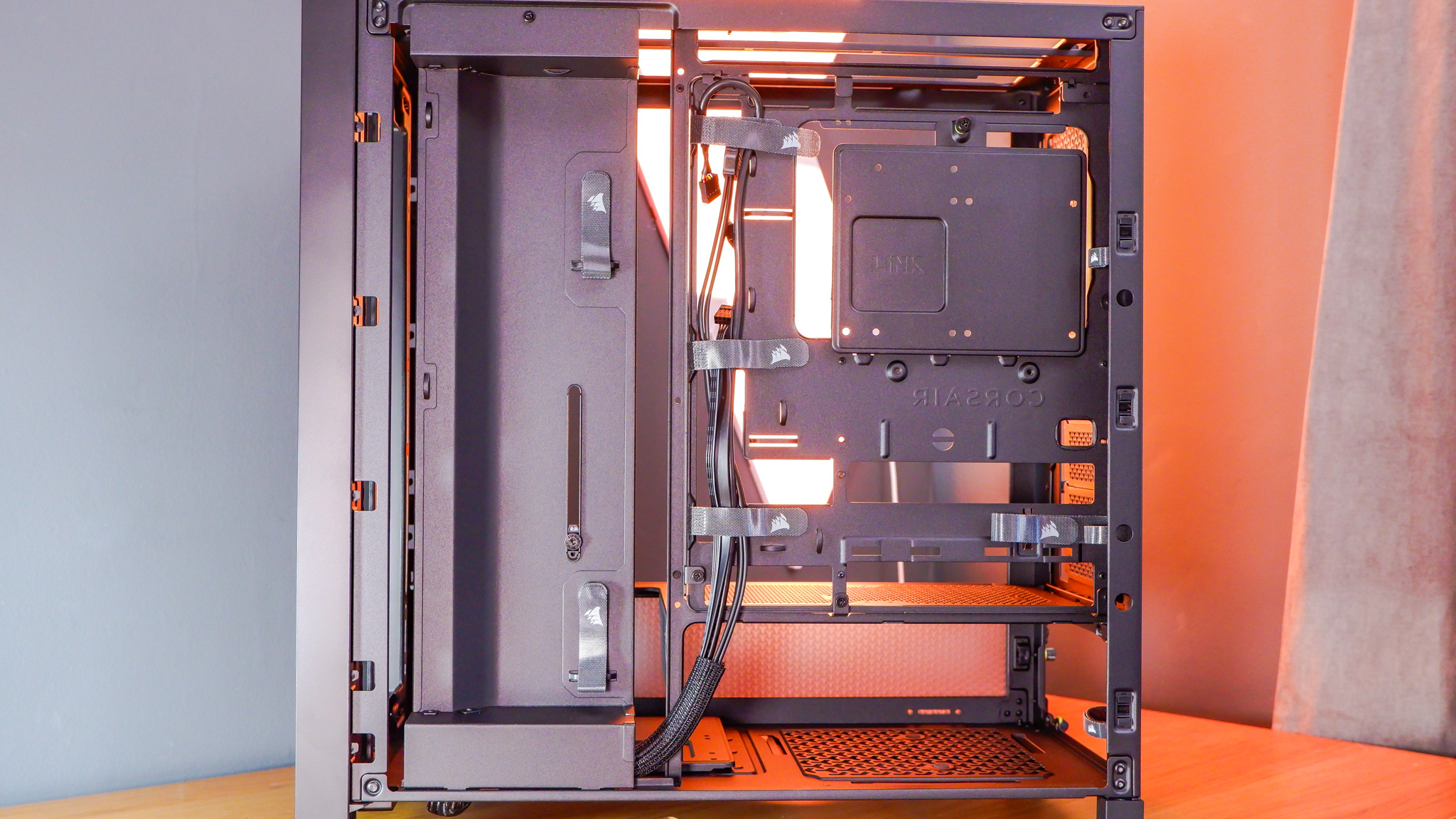
There is a lot of flex to the top vent and PSU shroud cover, which doesn't quite contain the mess of cables within, and while the power button stands out, I don't quite feel it matches the overall aesthetic. Overall, however, I'd be happy to sit this case on my desk and look at it for most of the day.
The Frame 4000D's main brag is that it offers high levels of customisation. Take the PSU shroud, for example. You can swap out the plastic card within the shroud to change its appearance, between translucent or black, or if you're a creative type, insert another card of your own design. You could also simply remove the card, or the entire PSU shroud, entirely. That comes in handy during the build for connecting PSU cables—unless you have a Corsair RMx Shift PSU, which this case is designed to fit.
Or take the cooling. There's room for up to 10 120 mm fans inside this rather compact case, lining the front, top, and side. To use that side mounting position to the right of the motherboard, you'll need to switch out the fitted cable cover with the extra mount included in the box. This is what I ended up doing to fit the Corsair iCUE Link Titan 360 RX LCD to the side of the motherboard, making good use of some reverse-orientation fans I have to hand and allowing me to stuff three 120 mm units in the front of the case for maximum cooling potential.
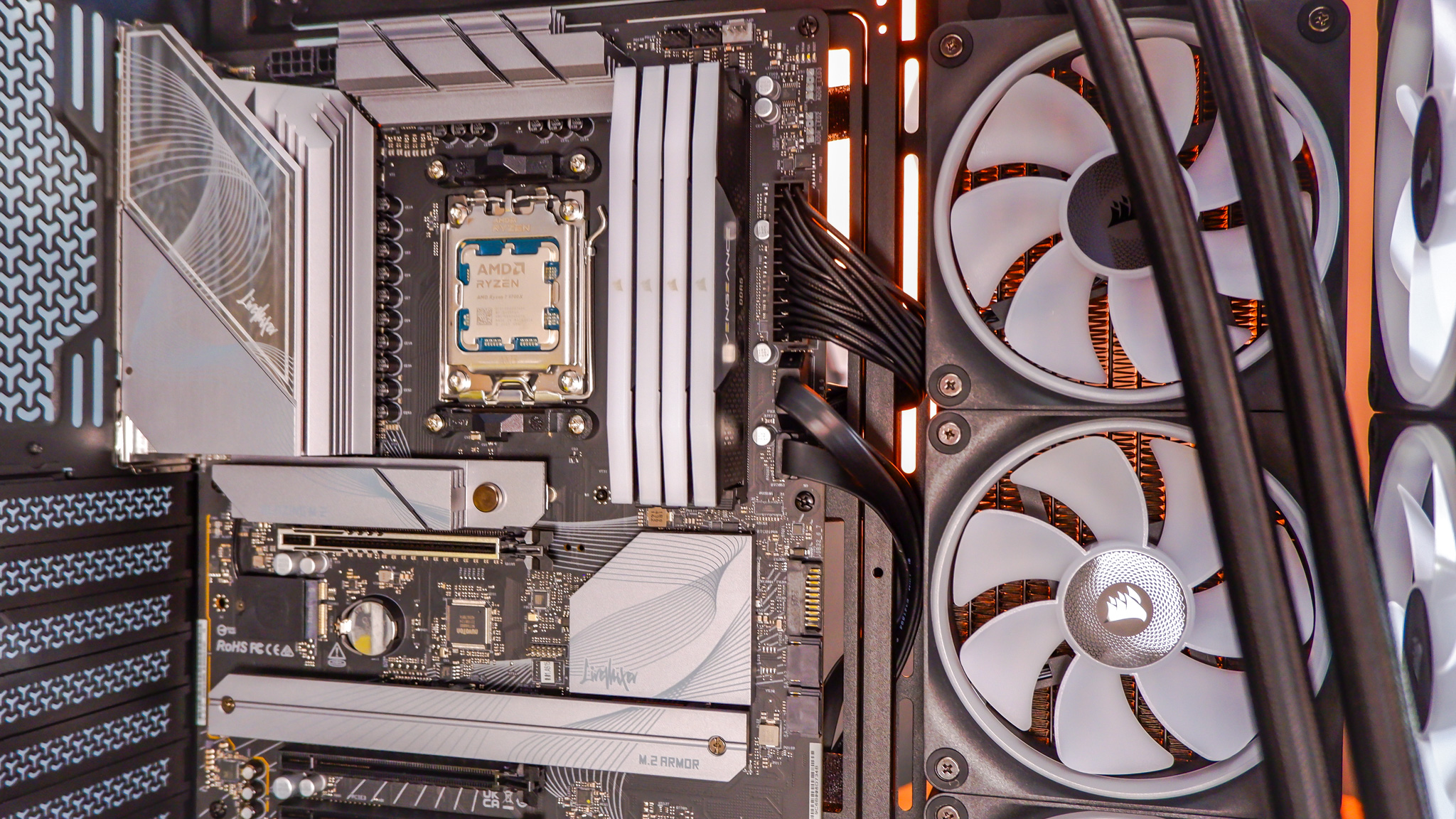
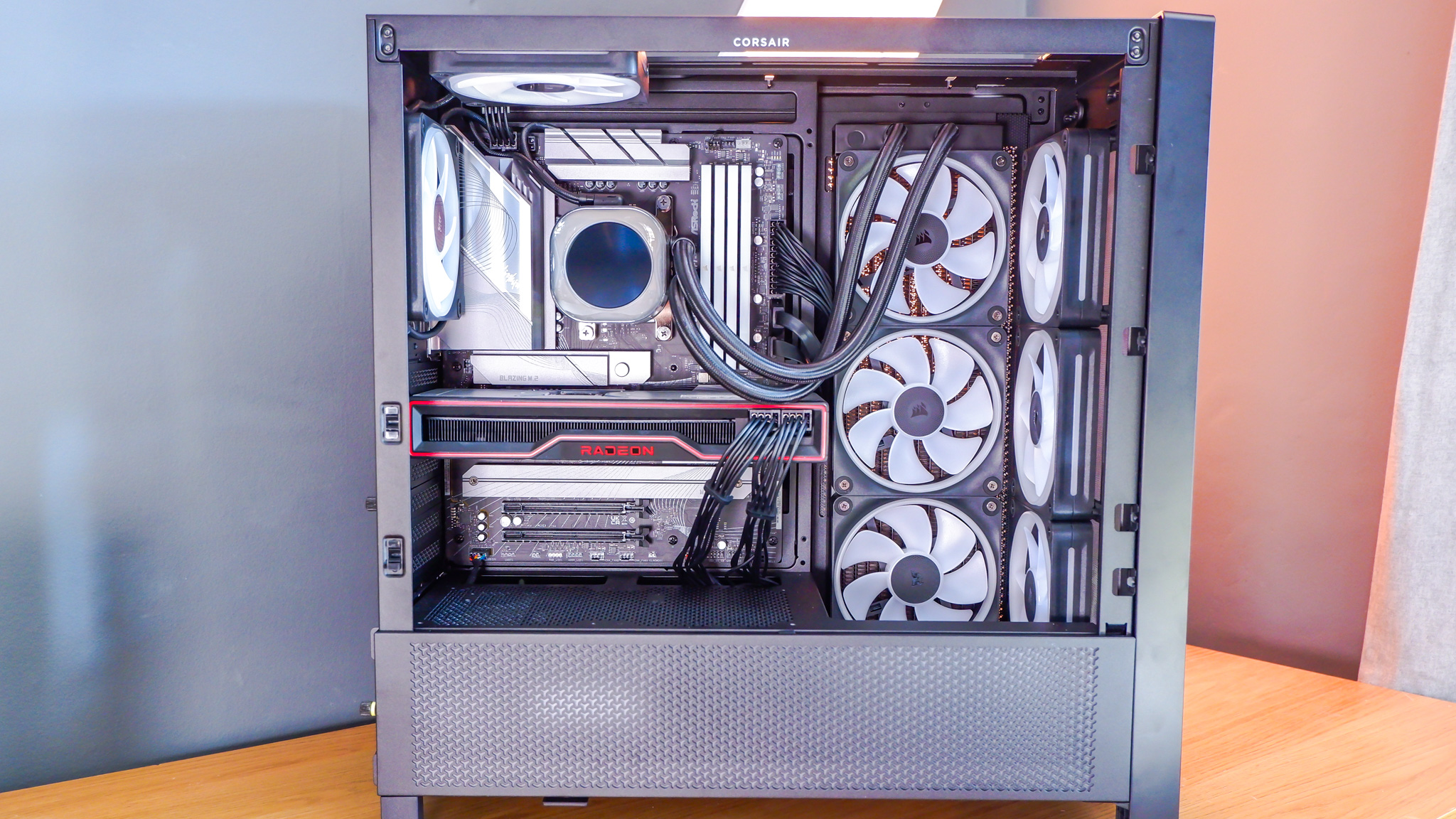
The mount comes away easily with a single screw and it's replaced just as easily, too. Though I did run into some difficulties with cable routing from removing the cable shroud. I guess that's to be expected, but using both side and front mounting points left me with no other option but to take up a lot of room to the right of my motherboard that would have usually been left spare for chunky motherboard and USB cables. It was a tight squeeze for the individually housed cables on the new Corsair RM850x I've installed in this machine, and a PSU with a less flexible motherboard cable might be an even tighter squeeze. If you had a wider radiator or E-ATX motherboard installed, fuggetaboutit.
Stick with the cable shroud pre-installed in the case and you score a built-in GPU support. This little arm moves up or down to fit a range of GPU shrouds, though that's the only axis of movement. They're not hard to find these days but you would need a relatively large GPU of at least 315 mm in length to reach the little arm. That rules out the Founders Edition 50-series cards.
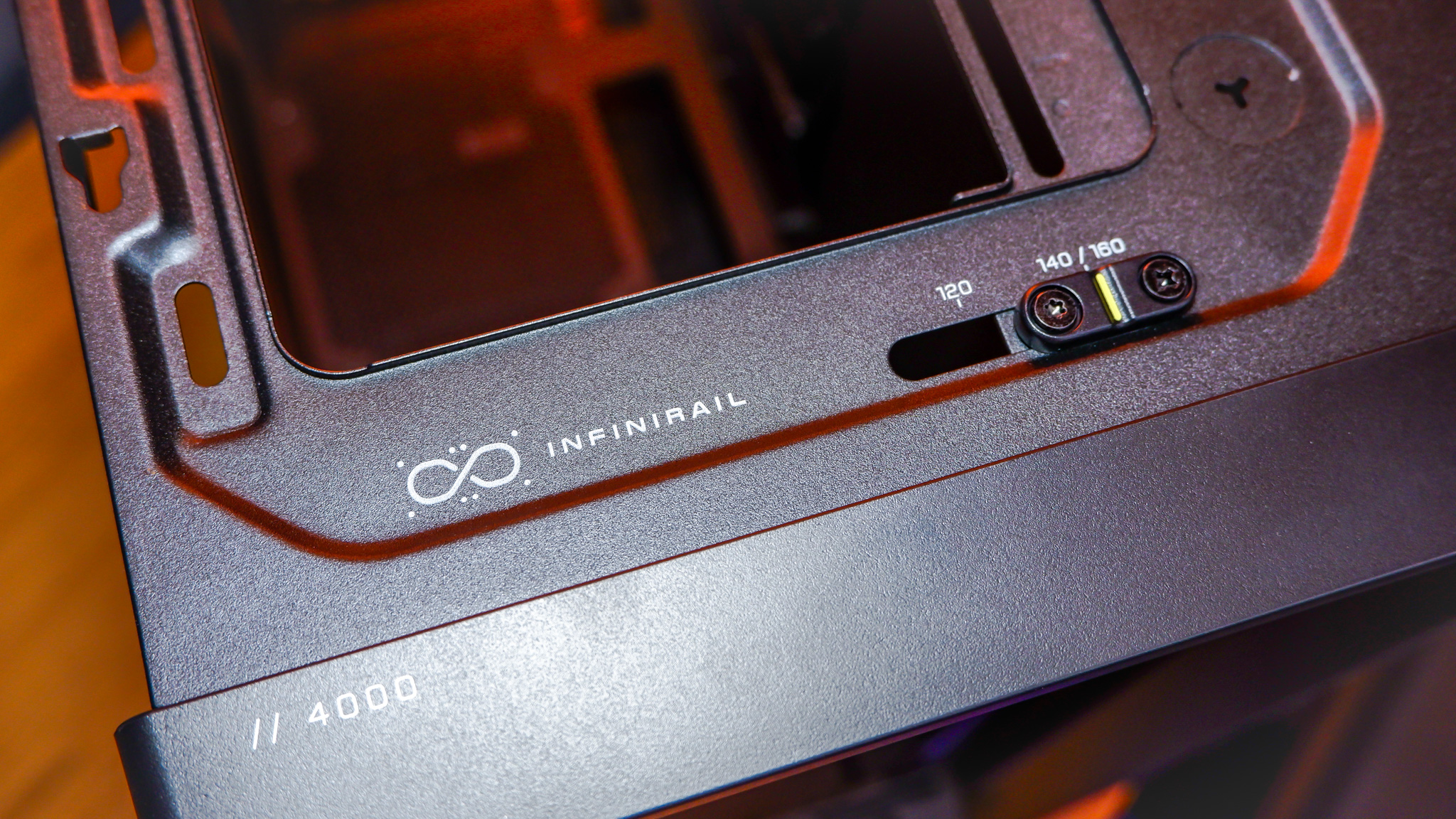
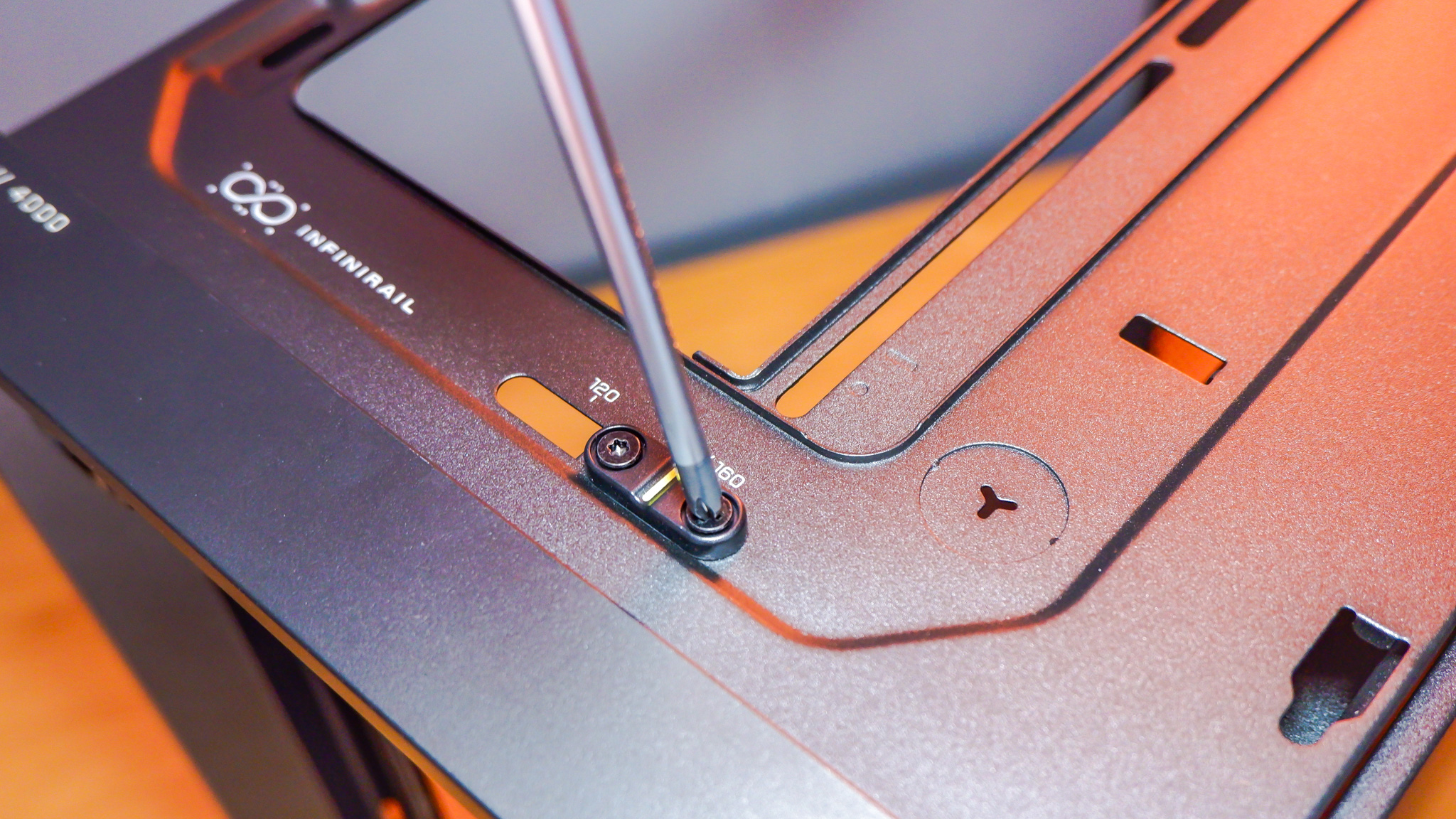
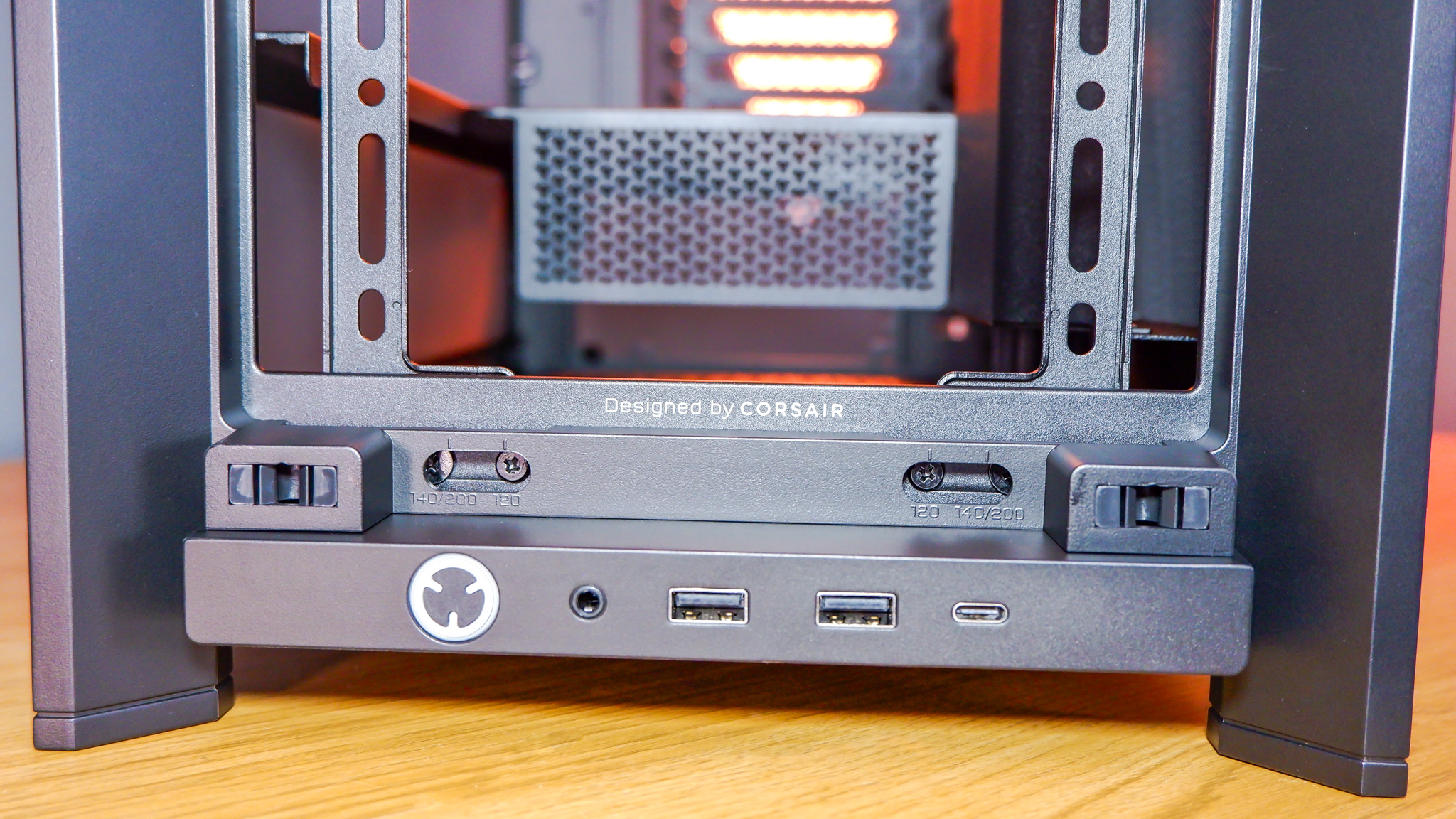
It's easy to install cooling fans in the front and top of the case, as these both use a new system from Corsair called 'InfiniRail' for support for a wide gamut of fan sizes and radiators—one of the Frame 4000D's clever features. This allows you to move the metal rails onto which fans can be mounted, between 120/140 mm up top and 120/140/200 mm in the front. While a little unnecessary compared to a more traditional set-up, it does work well and saves on unsightly rails or mounts slightly covering larger fans.
I only wish the front fan mounts offered a little more flexibility in how far these rails can move side to side—as it stands, the front fans leave some compatibility issues with the side fan mount and require small plastic clips if using 120 mm fans, which feels like it adds extra steps to, and slightly defeats the purpose of, this simplified rail system.
This Frame 4000D supports motherboards with rearwards connections, ie Back-connect or BTF. Also, take a closer look at the motherboard tray and you'll realise that, too, is removable. Why? Well, that's a good question, as right now there's not much to be done with it. However, some of the Frame 4000D's customisation options are still on the way.
One of the promises of the Frame 4000D is that it will be hugely upgradeable. On its website, Corsair writes that the case "evolves with your needs, offering near limitless options for upgrade and changes." While that might be true one day, there are no options for upgrades available right now, which does make judging its upgradeability much more difficult. I asked Corsair about this and I'm told accessories are on the way—presumably motherboard trays and new front panels are part of that incoming wave, as the latter is shown on the website—but nothing to see here for now.
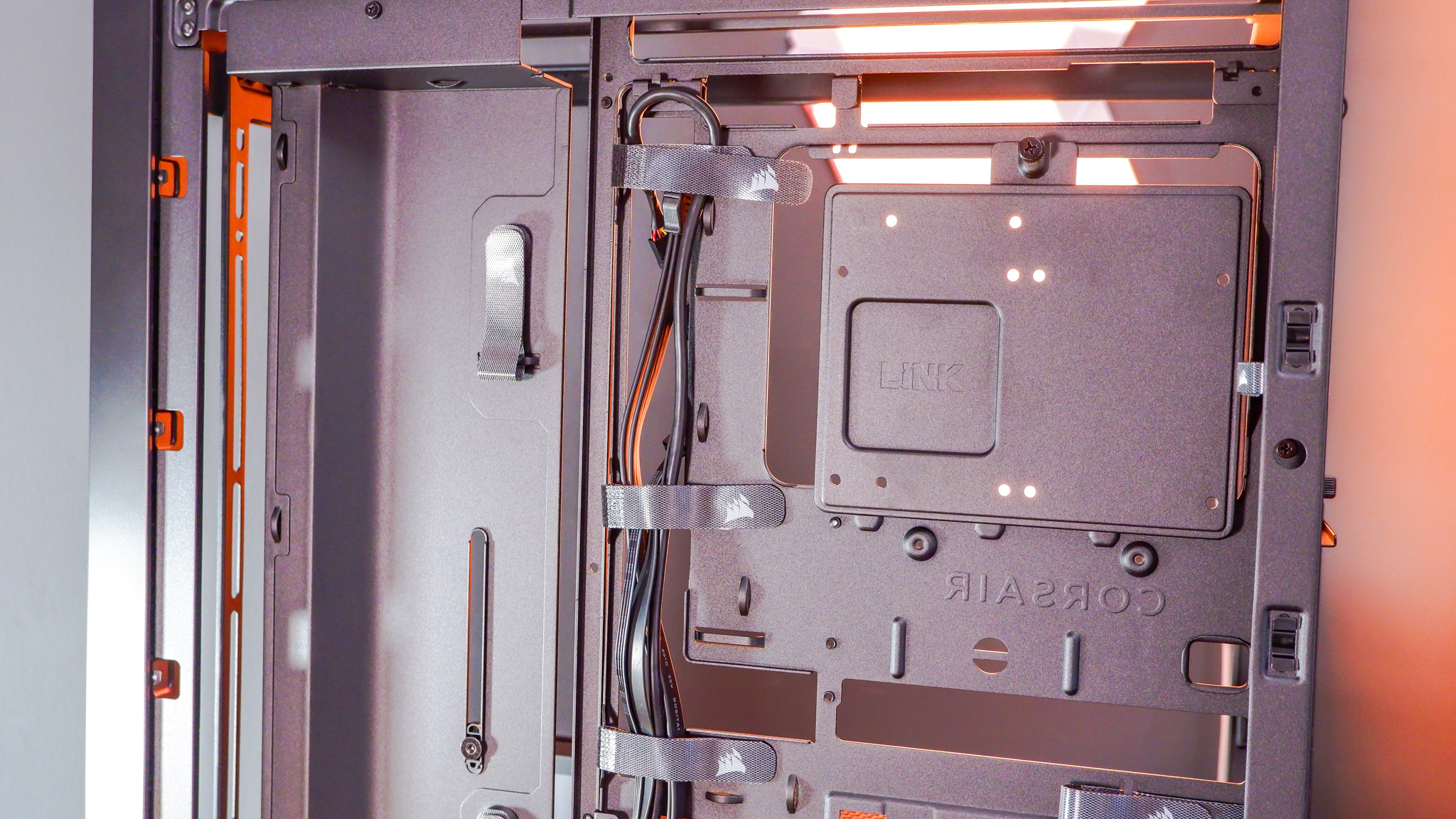
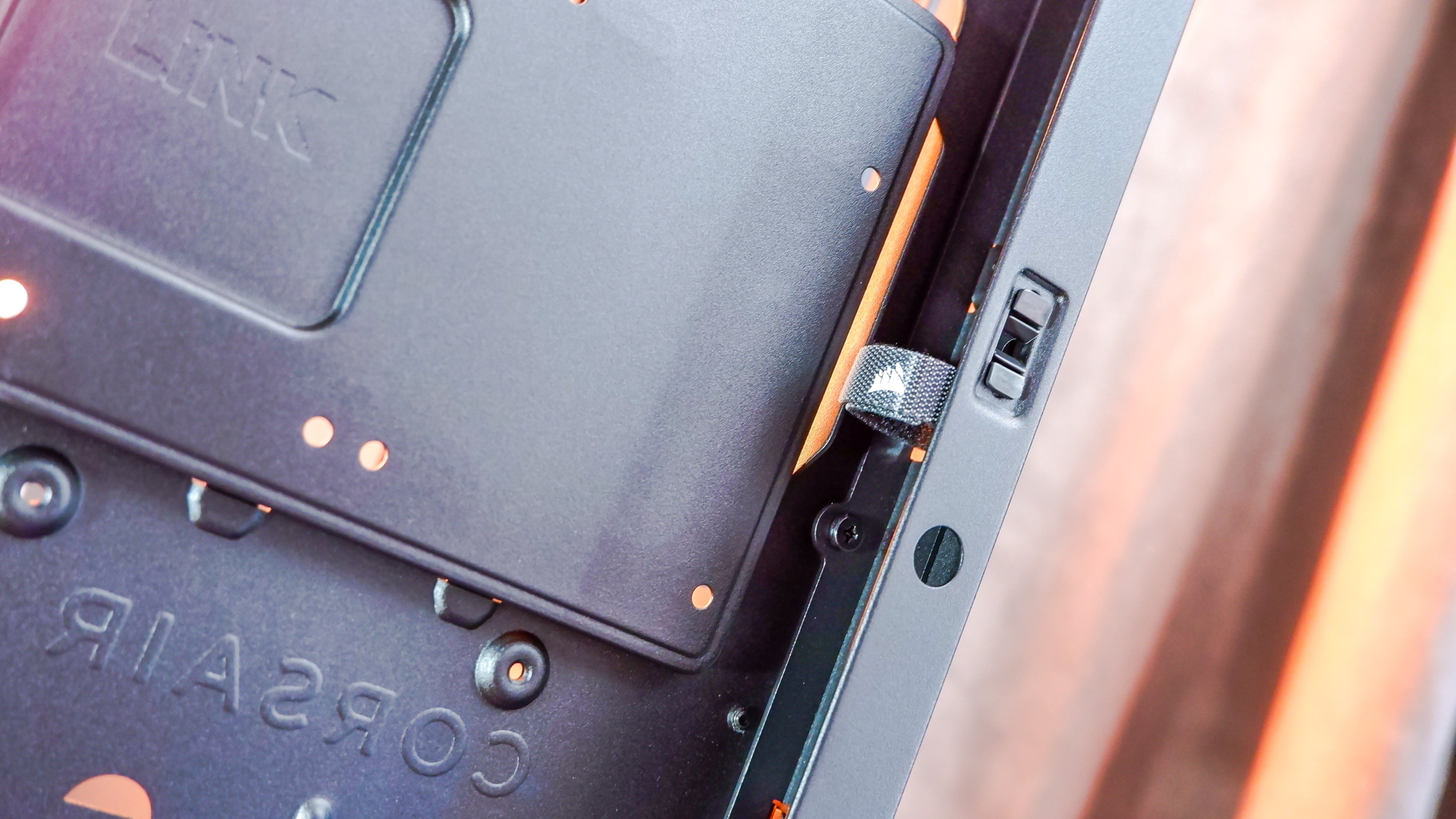
This case is filled with ways to tie down cables. Small hooks, cutouts, and cable ties are aplenty. There's a series of handy velcro straps down the rear of the case to keep your CPU power cable tidy, which I most appreciate of the lot. Though I will say that only works if your PSU has a reasonably long CPU power cable—many don't.
You can see these velcro ties from outside the case and that's because they work both ways. Using a little cut-out at the bottom of the case between the power supply and outer edge, you can feed a cable out and around the rear of the case, perhaps to install some RGB lighting controlled by, one would presume, iCUE, though actually you could use any system of your choosing. Before you say, 'who even does that?', I once dremelled a Corsair Air 540 to cut a hole for RGB light strips—I was young, I've matured since.
There's no denying that this is a case built for Corsair's software and hardware ecosystem, iCUE Link. The word 'LINK' is plastered all over the case, from plastic caps to two removable trays, one behind the motherboard and the other in front of the PSU, made to fit iCUE Link System Hubs.
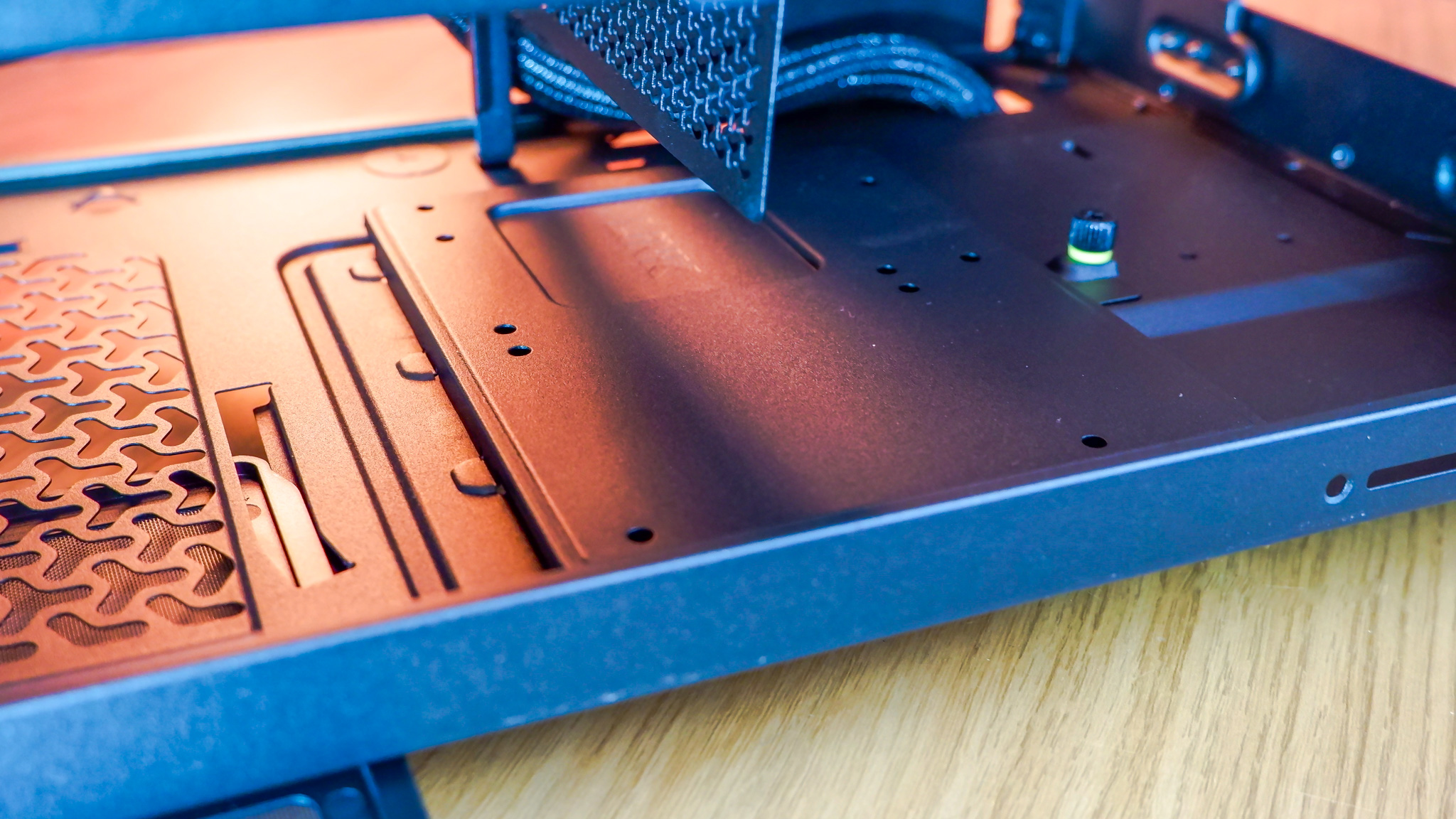
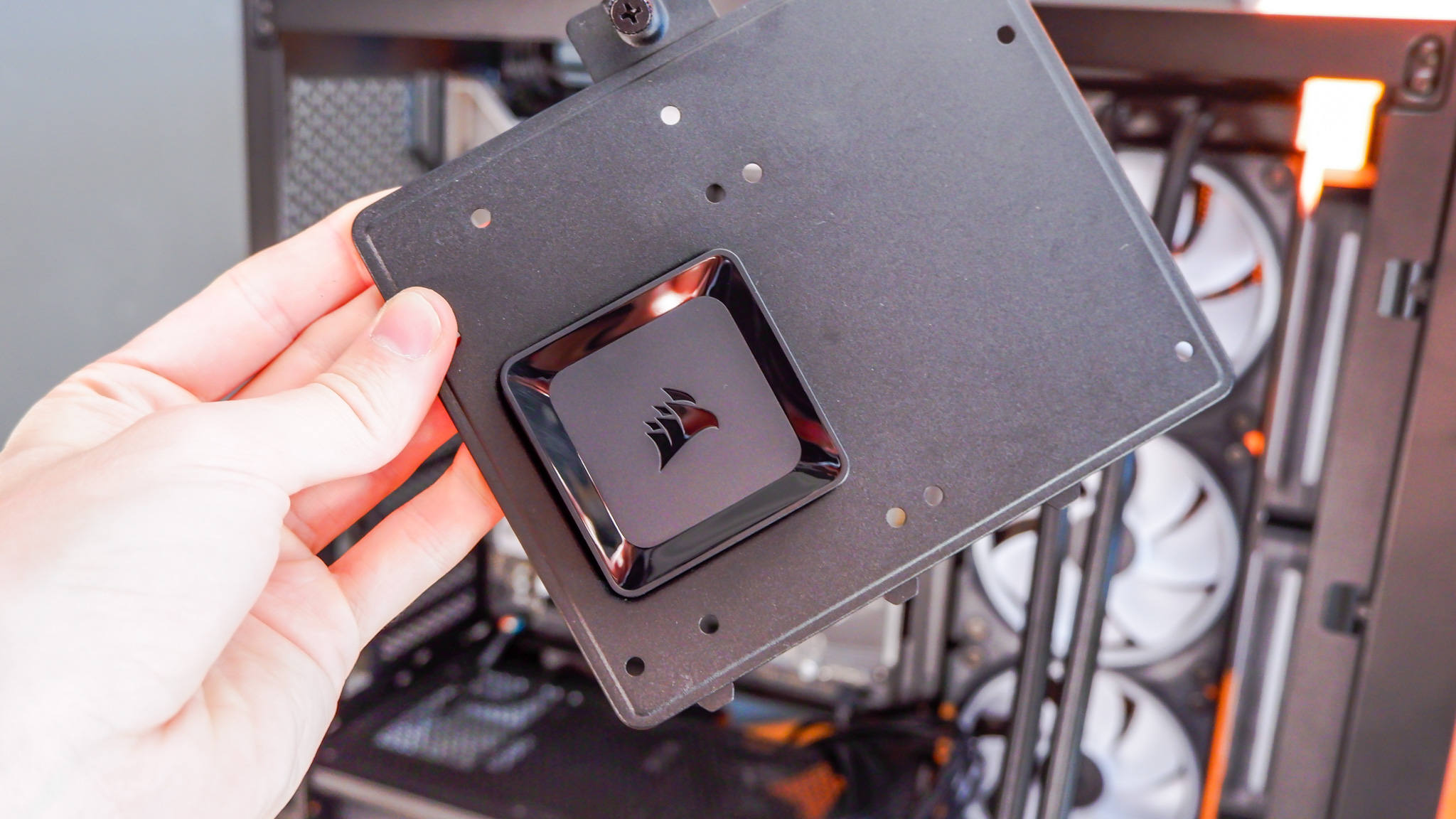
I've used a System Hub for my build, to hook up the liquid cooler and various fans throughout the chassis. This saw me feeding heaps of thick cables around the case, to daisy-chain components together, and in place of the traditional PWM and RGB cables that usually terminate at the motherboard. As such, I don't feel iCUE's system is particularly better at keeping cable mess down, as the old-school cables are thin and easy to hide, but if you must have all that RGB…
If you don't want to opt for Corsair's ecosystem, you could still benefit from the four 2.5-inch SSD mounting points or two 3.5-inch HDD mounting points across both trays.
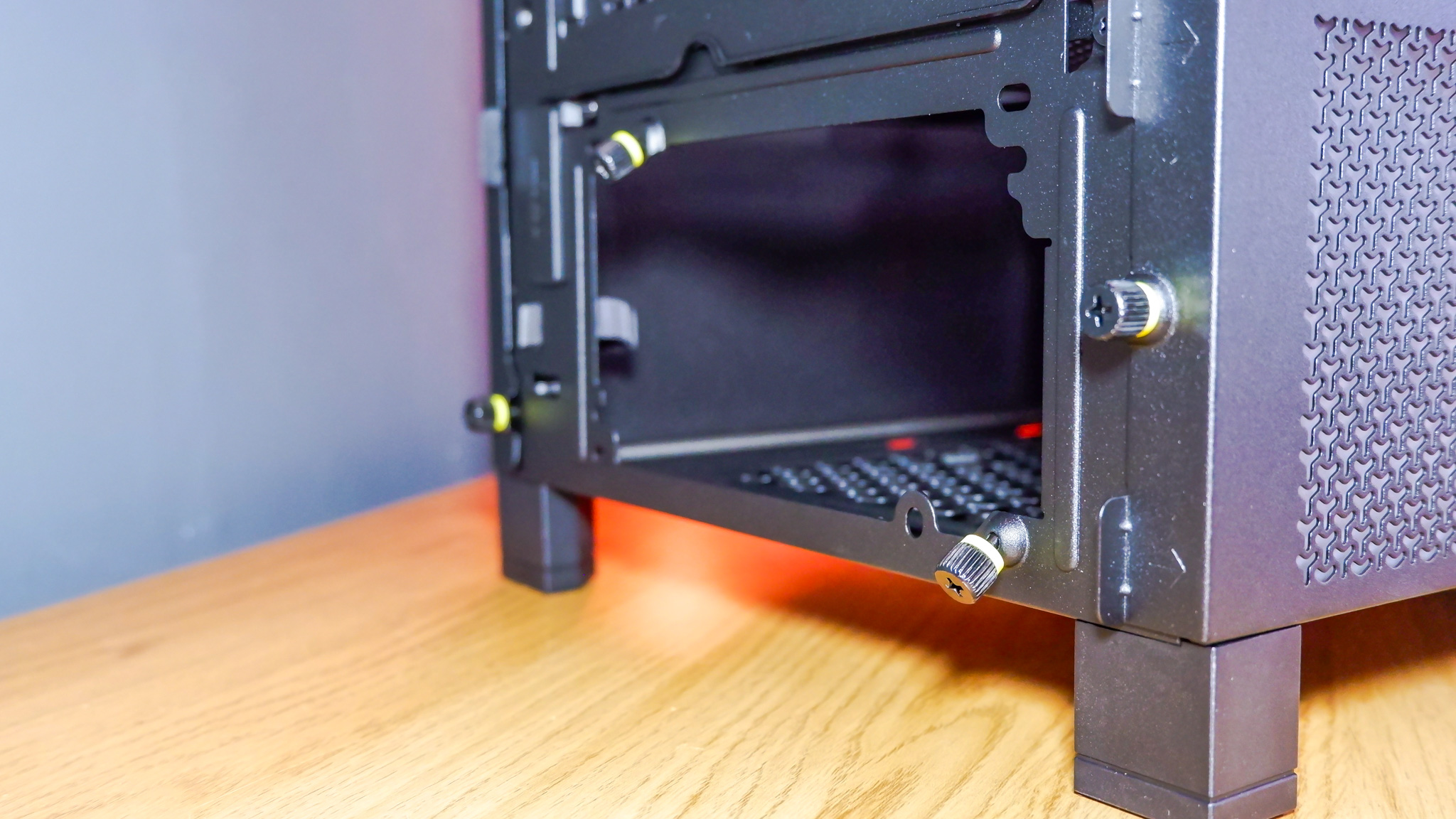
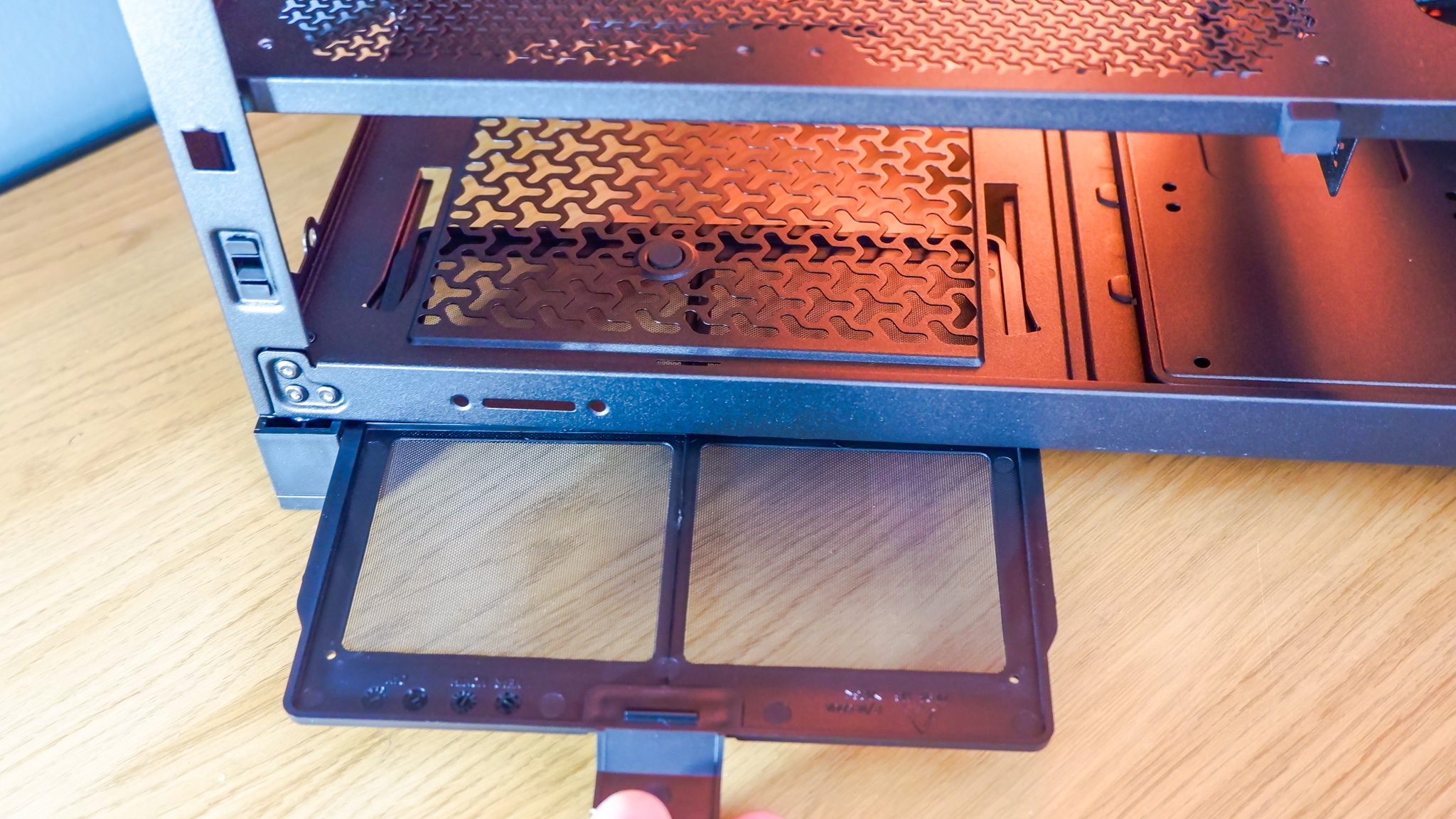
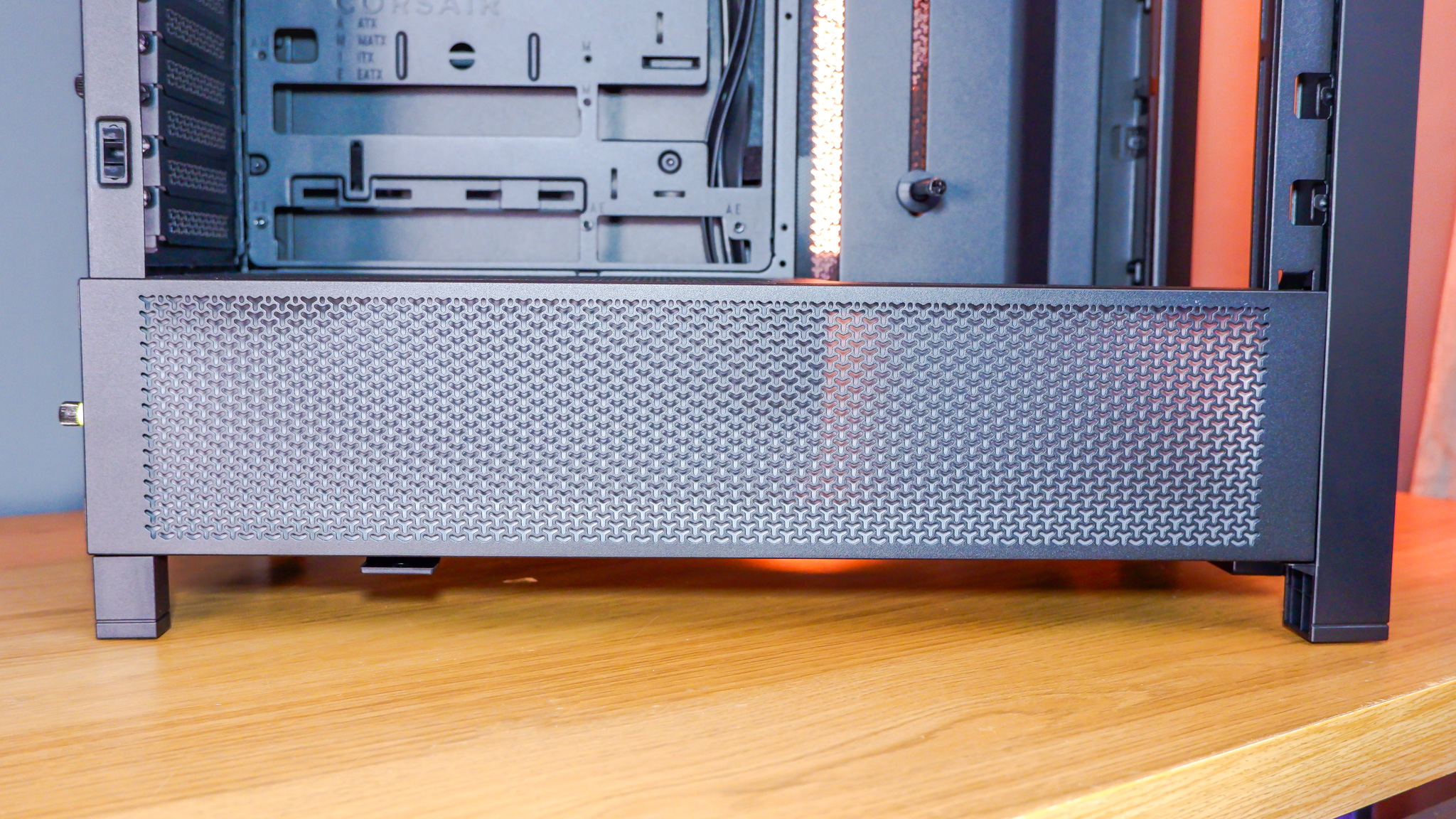
One easily overlooked feature that I'm a bit of a sucker for is the tool-free PSU mounting. Just slot your power supply into the cavernous shroud and tighten twin thumbscrews to lock it into place. As mentioned earlier, there's also been care to make sure there's room for a Corsair RMx Shift PSU in this case, which has the connectors sticking out sideways for easier access—one more friendly nudge from Corsair to go buy yourself some other Corsair products.
I do have some nitpicks with the Frame 4000D. For starters, I don't love the mass of unsightly cables from the front panel collected together beneath the PC case. Though, to be fair, who is peeping under your chassis? Then there's the InfiniRail system, which could be a little more flexible to let you mount fans in the front of the case and keep some clearance for cables with a side-mounted radiator.
Similarly, the lack of easily accessible cable routing around the motherboard, bar a large cutout atop the PSU and the very top of the motherboard tray, makes some cable runs a bit of a hassle. A little more room around the side and bottom of an ATX motherboard would go a long way. Though it is technically supported, an E-ATX motherboard may struggle for ample room.
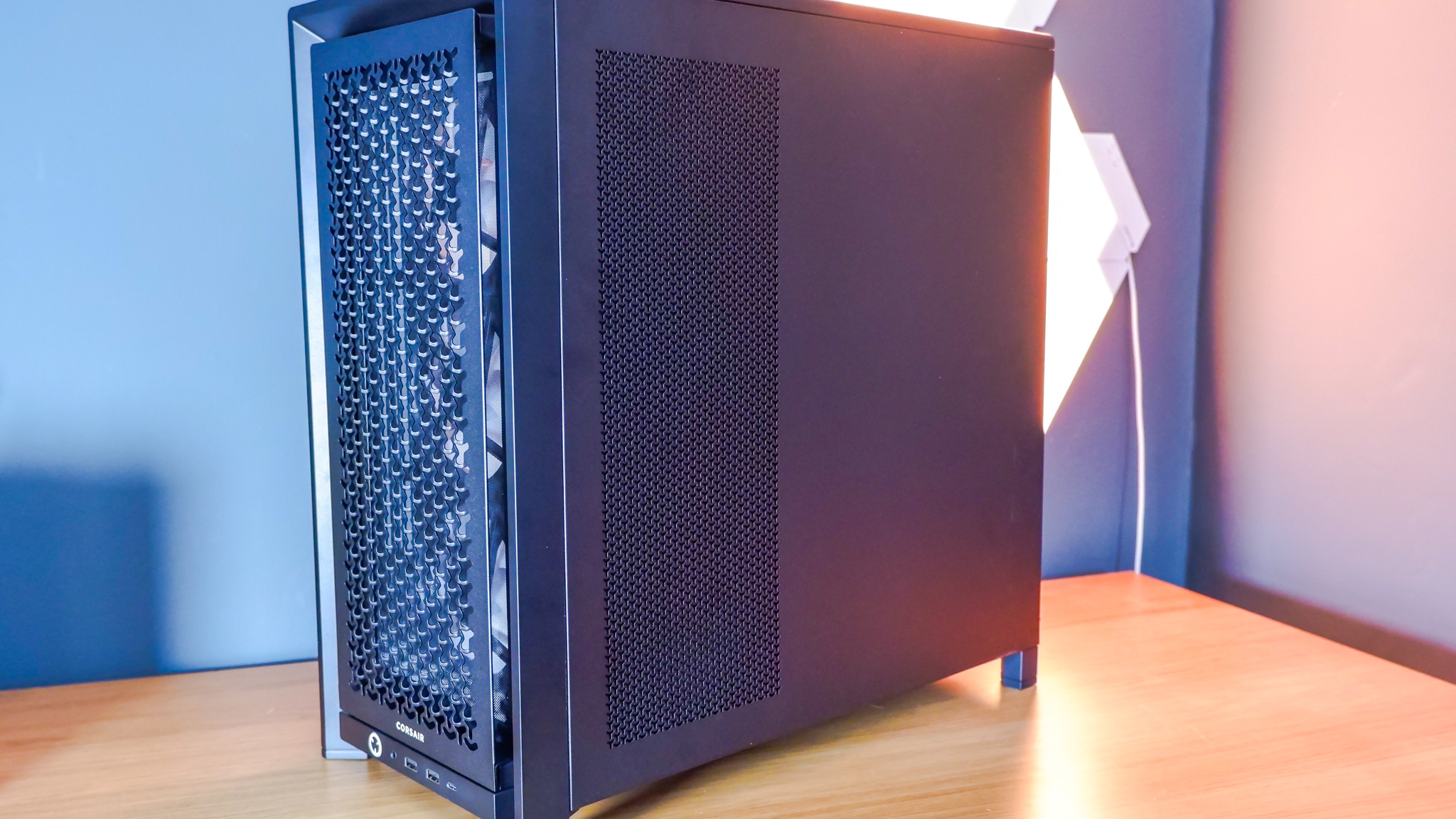
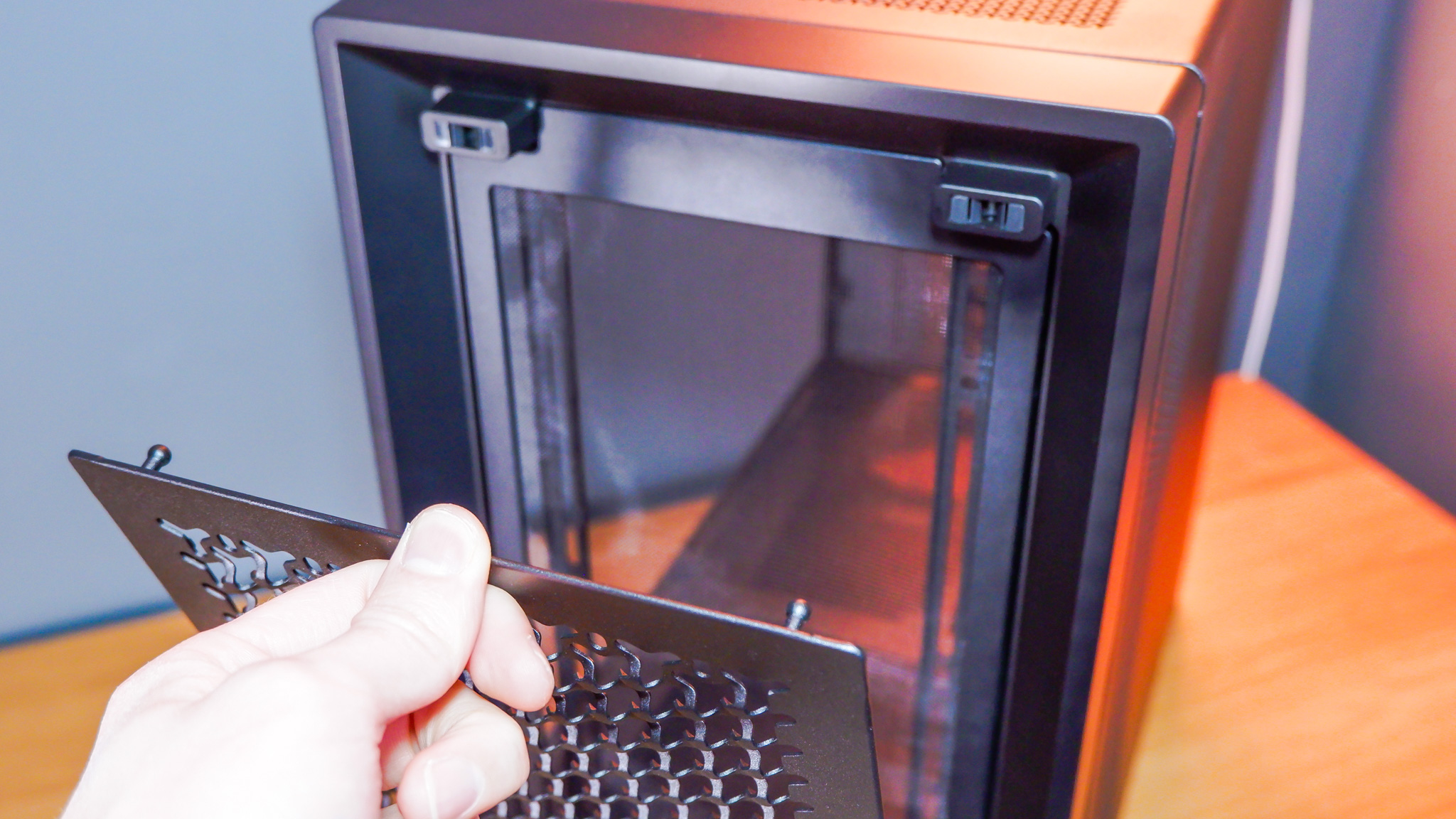
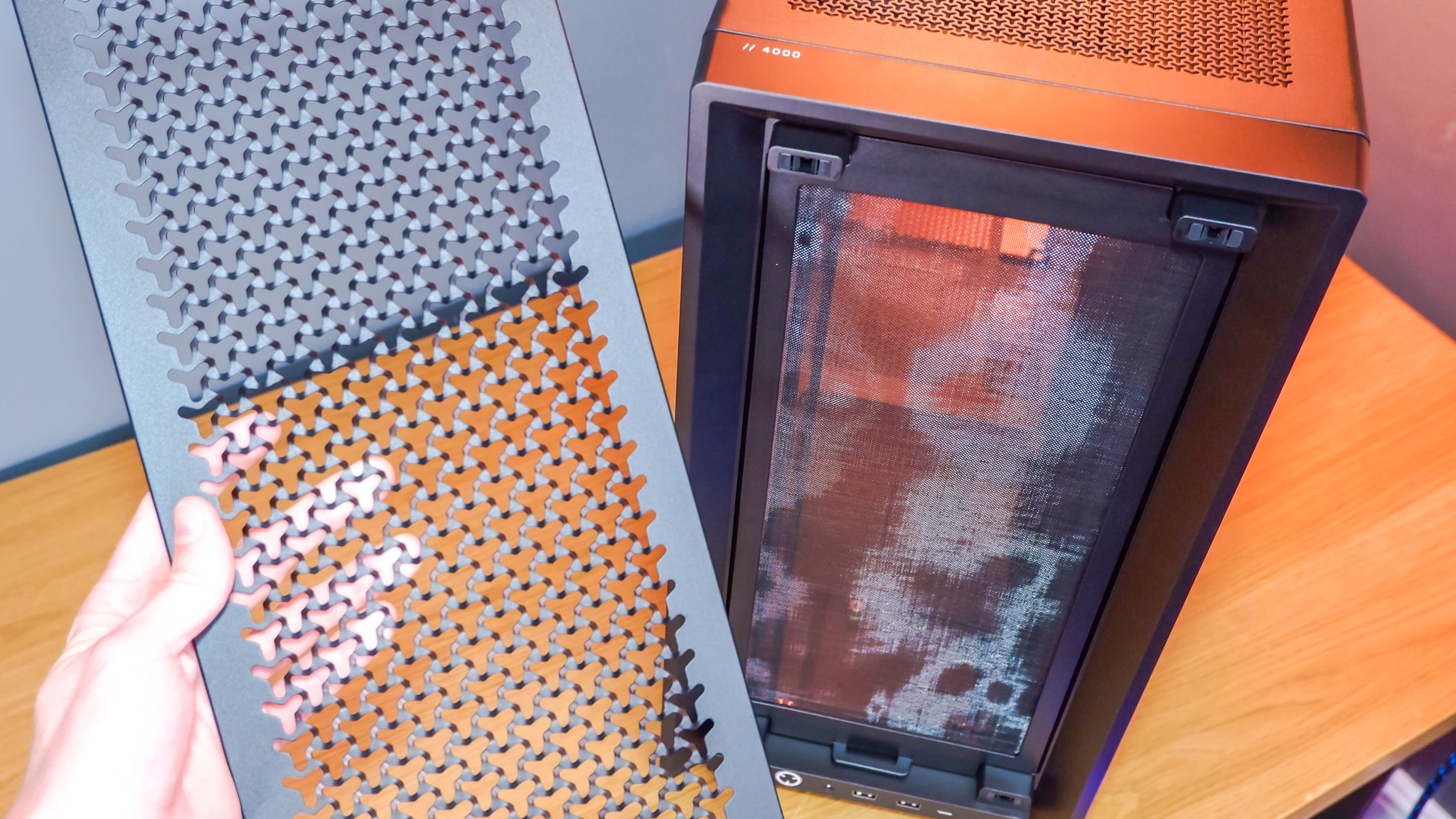
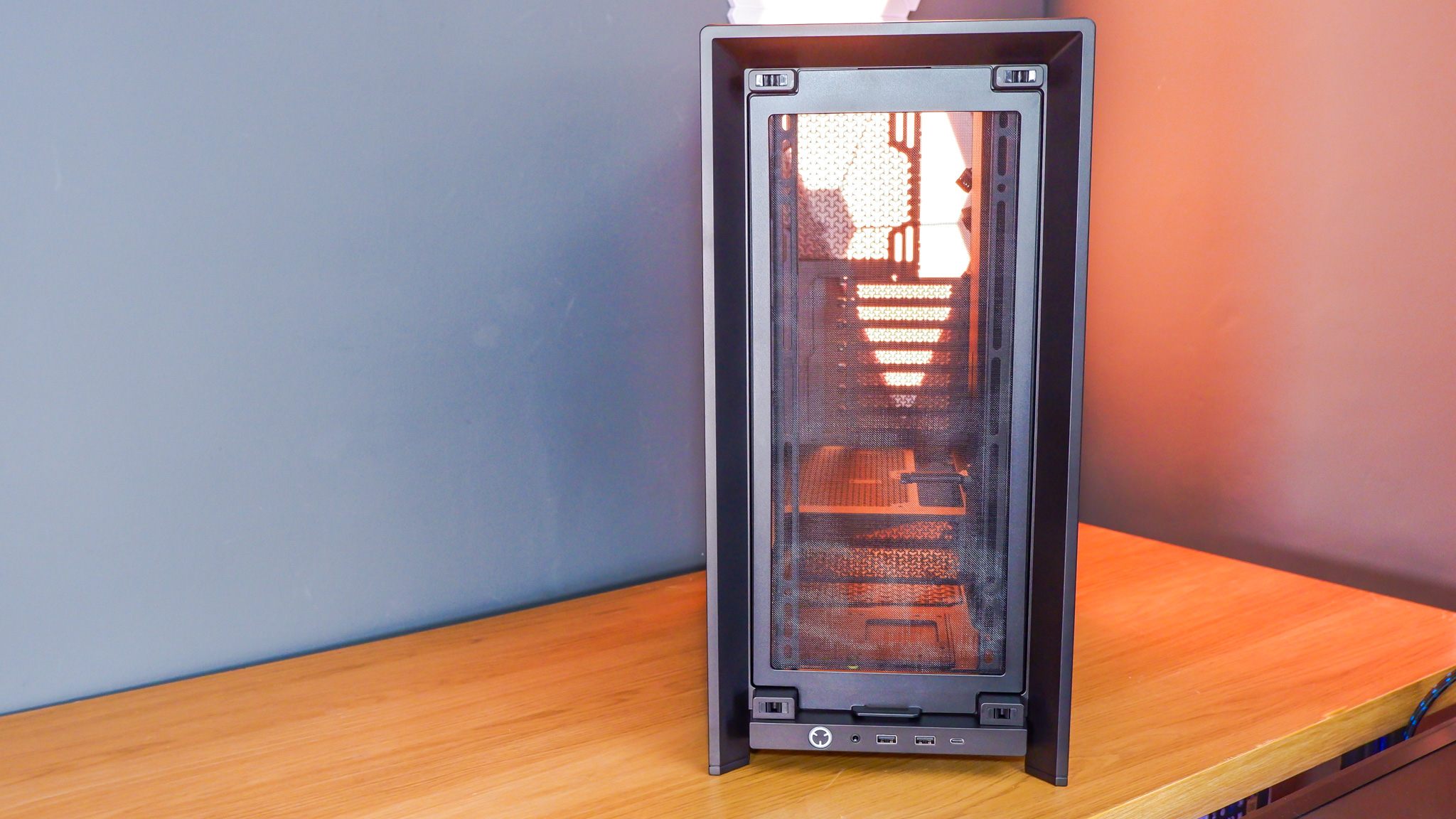
I also measured a fairly substantial drop-off in airflow with the magnetic dust filter on the front of the case. I measured 2 m/s airflow with neither dust filter or front panel attached to the case, and that didn't change much with the front panel reattached. However, add the dust filter in and it dropped to 1.5 m/s, which is a reasonably high drop just above the Phanteks G400A (0.1-0.4 m/s) and much higher than the Havn HS 420 (0.1 m/s). That said, with the amount of fans that can be fitted in the 4000D, it's hardly gasping for air.
And, as I mentioned at the start of this review, only three fans are provided with the more expensive versions of this chassis, leaving a space in the rear you'll need to fill. Presumably with a fan to match the other three.
✅ You are going to use iCUE Link extensively: This case makes the most sense within the Corsair ecosystem. Go all in on Corsair's fans, controllers, and lighting and you can use every inch of this case.
❌ You want easy cable management: With an ATX motherboard and using the included side radiator mount, I was left wishing for more generous cable routing options.
Lastly, there's a lot of flex to the top panel—significantly more than the MSI Pano 100R PZ, Corsair iCUE 4000T, Havn HS 420, and Phanteks G400A I have in my office to test against. And yes, I have too many PC cases, what of it? You could also easily bend the panel covering the PSU cables, and sure, maybe the thinness of the metal saves some weight, but at 10 kg this case is not much lighter than some competing cases (G400A is 10.5 kg).
Altogether, the Corsair Frame 4000D gets a whole lot right but has me wanting a few tweaks to really nail the formula. If you're not pushing it to its limits, you wouldn't be putting a foot wrong building your next PC inside it, and that's doubly true if you're going to go all in on iCUE.
I just wish Corsair had something to show for its promised customisation right now, as I can't really judge this case on the ecosystem of parts promised alongside it, as none of it is here yet.
Whether you're a Corsair iCUE fan or not, the Frame 4000D is a good choice among a sea of options for its $95/£80 price tag. Saying that, Corsair fans are set to get the most out of it, and for first time builders, I'd recommend more convenient cases such as the Be Quiet! Shadow FX 800 and Phanteks G400A with four pre-installed fans and more room to manoeuvre.
The Corsair Frame 4000D is a feature-filled chassis with a decent price tag. It's absolutely built for those with an iCUE obsession and it looks superb with fans a-blaze in RGB hues. However, there is room for improvement and I'd like to see Corsair roll out lots of customisation options to really make this case sing.

Jacob earned his first byline writing for his own tech blog. From there, he graduated to professionally breaking things as hardware writer at PCGamesN, and would go on to run the team as hardware editor. He joined PC Gamer's top staff as senior hardware editor before becoming managing editor of the hardware team, and you'll now find him reporting on the latest developments in the technology and gaming industries and testing the newest PC components.
You must confirm your public display name before commenting
Please logout and then login again, you will then be prompted to enter your display name.
